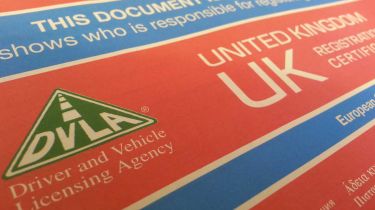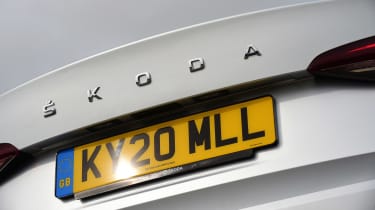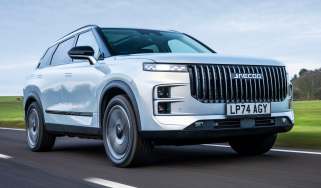How to change ownership of a vehicle
Buying or selling a used car? The easiest way to legally transfer a car to its new owner is via the DVLA website online

If you’re buying or selling a car, you’ll need to know how to change the registered keeper on the logbook. Changing ownership of a vehicle has become much easier with the help of the internet, as the whole process can be sorted through the DVLA’s online tool. It can also still be done at a post office or by sending the green slip of the logbook away if you prefer. You’ll need to transfer ownership of a car before you can insure it and obtain VED (road tax).
 How to buy or transfer a personalised number plate
How to buy or transfer a personalised number plate
It’s important to clarify the difference between being the owner and the ‘registered keeper’ of a car. If you fill out the V5C slip and hand it to the new owner, this doesn’t necessarily transfer ownership of the vehicle, but they do become the registered keeper. In most cases this will equate to the same thing, but a vehicle’s owner could also be the company the registered keeper works for (in the case of company cars) or, if you buy the car on finance, the lender who has provided it.
Your V5C (also known as a logbook or Vehicle Registration Certificate) is one of the most important pieces of documentation for your car. Whether or not you carry out the transfer of ownership online or via post, you’ll need the V5C to do so. There’s a unique 11-digit Document Reference Number printed on it which will need to be entered as part of the process.
You will also still need to tear off the green New Keeper Slip for the new owner, which is section 6 of the V5C on the bottom right hand side of the third page. Fill out the box marked Date of Sale/Transfer and make sure you hand only this slip to the buyer. Make a note of their full name, address, postcode and hopefully their email address before they drive off.

If you lose the V5C, you should apply for a new one before transferring ownership. This costs £25 to replace and you’ll need the car’s registration number, VIN/chassis number and the name and postcode the logbook was registered with to get a replacement.
Fines for failing to notify DVLA of a transfer
Now that the new keeper has driven away, they can use the green new keeper’s slip as proof of ownership if they are stopped by the police. However, just because the car has physically left you, you still have a responsibility to notify the transfer of ownership to the DVLA. If you fail to notify the DVLA you are liable for a penalty in the form of an Out of Court Settlement letter demanding that you pay £55, reduced to £35 if you pay within 17 days. If you ignore this letter, the case could be taken to a magistrate’s court, and the potential fine increases up to £1,000.
How to use the DVLA online transfer system
Fortunately, recording a transfer of ownership with the DVLA couldn’t be simpler. With your logbook/V5C to hand (now minus its New Keeper Slip), look up www.gov.uk/sold-bought-vehicle on your smartphone or computer and click the big green ‘Start Now’ button.
The next steps are very simple and are mostly multiple-choice questions. Firstly, you must click ‘yes’ or ‘no’ to declare whether or not you are a motor trader. Then the following options will confirm whether you have sold or merely transferred the vehicle, and who you sold it to, whether an individual or a trader.
 Questions to ask when buying a used car
Questions to ask when buying a used car
After confirming who you and your buyer are, you’ll then need to confirm the car’s details. You will need to confirm that registration number and vehicle details are correct. After this, the full name, postcode and address of the new owner and the date of sale will need to be entered. Again, these steps are very clearly laid out and simple to follow. If you enter your email addresses, you and the new buyer will both receive a record of the changes.
The final page is a declaration that the details you have entered are correct, and then it’s simply a matter of hitting the ‘Confirm’ button.
That’s it, job done. You’ve successfully transferred ownership of your car and fulfilled your legal obligations to record the change with the DVLA. A new logbook/V5C will be issued automatically, and you are advised to tear up and dispose of the old V5C (yes, really – it may sound drastic, but that is the official advice).
Transferring car ownership by post
If you prefer to use the V5C document to notify the DVLA of a transfer of ownership by post, you must enter the new owner’s name and address into the boxes on section 2 of the document – the green panel on the bottom left hand side of page two.

You must then tear off the New Keeper Slip, fill out the Date of Sale/Transfer, and hand the slip to the new owner. The remainder of the V5C, including section 2 which you have just completed, must be posted to the DVLA, Swansea, SA99 1BA, as directed on the form.
Who is allowed to transfer car ownership?
The V5C is created by the DVLA as soon as it is first registered, and may be sent directly to the owner's home address. It's worth remembering, too, that the name on the registration certificate isn't necessarily the vehicle's owner but the vehicle's keeper. Essentially, the keeper of a vehicle is the person legally responsible for it, even if another party actually paid for it.
Only a vehicle's registered keeper can legally transfer a car and its logbook into another name. Although the keeper of a car isn't necessarily its owner, they are responsible for its legal use, including insurance, tax, registration and roadworthiness. As the keeper's name is the only one to appear on the registration document, it is they who could face legal proceedings in the event of a motoring law being broken.
Whether selling your car or giving it away, you should inform the DVLA of a change of keeper, and that should be done immediately at the point that the vehicle changes hands.
Whether you inform the DVLA online or by post using the V5C, you’ll find a space to enter the car's mileage: this is optional but enables future owners to verify the car's mileage. There's also a space for the driving licence number of the new keeper, but this is not required by law.
Selling or transferring your vehicle to a motor trader
If you are part exchanging your car or selling it to a motor trader, dismantler or scrapyard, you can do this simply by selecting the relevant options on the DVLA online system. If you prefer to do it by post, you will need to fill in section 4, separate it from the rest of the V5C and send it to the DVLA at the address above. The rest of the V5C must be given to the trader, dismantler or scrapyard.
Permanently exporting a vehicle
Section 5 of the V5C is concerned with permanently exporting a vehicle, so that it no longer appears on UK roads. It requires only that the date of export is entered and a declaration signed. This section must then be removed and sent to the DVLA at the address above – you cannot do this online.
The remainder of the V5C should be given to the exporter, who will need to use it in the country to which it is being exported.
For more information on buying and selling a car, read our guide to the V5C logbook, or our hints and tips for the best way to sell a car
Most Popular

Volvo EX40 review – the re-badged electric XC40 is a posh family EV
Tips & advice

Car dashboard warning lights: what does each symbol mean?

Electric car charging stations: public networks, charger types, apps and maps








